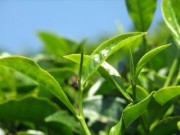|
Tea Varietals
All types of tea - green tea, oolong tea, black tea - come  from the tea plant, Camellia sinensis. The differences between these three classes of tea comes from the way the tea is processed after the leaves are picked. Green tea is an unoxidized tea, oolong tea is partially oxidized and black tea is fully oxidized.
Oxidation is a natural process which causes vegetation to turn dark after it is picked. Green tea is produced by steaming the tea leaves shortly after they are picked. Steaming halts the oxidation process, resulting in dried tea leaves which retain their bright green color.
Oolong tea is a partially oxidized. After picking, the tea leaves are tossed in large bamboo baskets to bruise them slightly. Afterwards, they are exposed to the air for several hours which begins the oxidation process. Oxidation is halted by pan roasting the leaves.
Varietals
Camellia sinensis is the species which produces all types of tea, but within that species there are plenty of varieties (or cultivars or varietals).
The marvelous plant which produces all the world's tea has more than 3000 hybrids. These are referred to as varietals - a term borrowed from the world of wine grape cultivation.
Tea varietals are developed with an aim to producing a particular type of tea in a particular locale. Varietals suited for the production of Indian black tea, for example, do not necessarily make a good Japanese green tea.
Taiwan Varietals
Taiwan has been producing oolong tea for about 200 years. During that time tea farmers and scientists have developed varietals which are well-suited to oolong tea production in the climate and soils of Taiwan.
Some of the most common Taiwan varietals are:
Qing Xin (Green Heart) - The most sought-after varietal in Taiwan. A dominating majority of today's Taiwan high mountain oolong teas are produced from the leaves of Qing Xin tea trees. The tea typically is richer, smoother and more fragrant because the tea leaves of Qing Xin trees grown in high mountain areas are thicker. The higher the altitude the thicker the tea leaves. The tea trees are hand picked instead of machines due to potential damaging effects from machines. Teas made of Qing Xin leaves come with an unique varietal fragrance and it is one of the reasons why these teas are so popular and thus very expensive.
Jin Xuan (Milk)- Also known as Taiwan #12. It is a new varietal developed by tea researchers in Taiwan around 1985. The tea trees are mostly grown at tea plantations located below 1600 meters above sea level. However, there are still some planted at high mountain areas to produce first grade high mountain milk oolong tea. Jin Xuan is productive and solid. It is perfect to be harvested by machines without being damaged. It can be used to produce a variety of teas.
Cui Yu (Green Jade)- Also known as Taiwan #13. It is a new varietal developed by tea researchers in Taiwan similar to Jin Xuan. Both varietals were announced around 1985. Cuiyu is mostly found at low altitude tea plantations. Cui Yu is also similar to Jinxuan in terms of productivity and solidness. Both of them are perfect for machine harvesting.
|